Your cart (0)
Your cart is empty
Tax included and shipping calculated at checkout
Drawer menu
Tax included and shipping calculated at checkout
Within the ring family, wedding, eternity and engagement rings deserve a special section. At present, in Western countries, as in other times of history, rings have been closely linked to a vow or a promise, hence the term engagement ring. Engagement rings usually feature precious stones (diamonds, garnets, spinels, topazes, tourmalines, etc.) and noble metals, such as gold and/or platinum.
Contents
We have been using rings for millennia. Whether it be to adorn ourselves, as a status of power, wealth or a reflection of our marital status (whether past, present or future), both men and women use them.
In spite of all the technological changes and all the variations in customs and fashion, there are few things that have changed as little over time as rings. The essence of a ring remains unchanged, a band made of metal or other materials, either elaborately or simply embellished and sometimes adorned with gems, all wrapped in a whole lot of symbology and feelings.
One of the clearest examples of the eternal beauty of this piece of jewellery is the two-finger ring: this type of ring was used in times of the Roman Empire and the Byzantine era during the fourth, fifth and sixth centuries around the Eastern Mediterranean Region. They consisted of two welded, gold rings, and they were usually adorned with gemstones, such as amethysts, emeralds, pearls, aquamarines, sardonyxes, garnets, etc.
Today, we continue to see the same design adorning the fingers of famous stars such as Beyoncé, or as part of the catalogue of the best jeweller designs, such as Boucheron's wonderful two-finger ring made with rock crystal and diamonds, Rives du Japan Ricochet collection.

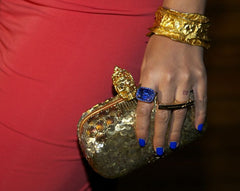
Roman two-finger ring - 4th c. British Museum, Beyonce with two-finger ring (Brooklyn Bridge).
Within the ring family, wedding, eternity and engagement rings deserve a special section. At present, in Western countries, as in other times of history, rings have been closely linked to a vow or a promise, hence the term engagement ring. Engagement rings usually feature precious stones (diamonds, sapphires, emeralds, topazes, tourmalines, etc.) and noble metals, such as gold and/or platinum.
The custom is that the male gives his beloved a ring, and that by accepting the ring, she also accepts his future marriage proposal. The engagement ring is a tangible object symbol of a future contract.
The history of engagement and wedding rings goes back millennia.
Everyone likes to design and customize this little metal ring cylinder loaded with symbology. But, how have wedding rings and engagements evolved to this day, when were they first used, and who used them? To discuss all this, we will have to go back in time and accept the fact that that there are some things that, from the ancient Egyptians to our own times, have remained unchanged.
The fascination we feel towards jewels is as old as our own history. The first prehistoric archaeological remains date back 85,000 years, to Taforalt or the "Grotte des Pigeons", a cave located in the north of Oujda, Morocco; in this cave were shell beads covered with red ochre, which were used as adornments. We could say that these shells were our very first "jewels".
The closest thing we can find to wedding or engagement rings in prehistoric times, as far as symbology is concerned, are strands of braided grass that our ancestors wore wrapped around their wrists, ankles or waists of their female partners over 40,000 years ago. Although the act itself was not in fact as romantic as it may have seemed at first glance, given the fact that according to anthropologists, the purpose of such a "jewel" was to be able to control the spirit of the woman.
The first vestiges of wedding and engagement rings dated back to Ancient times.
More than 6000 years ago, the ancient Egyptians endowed the ring with a special symbolism: "eternity". These rings were initially made from hemp or reeds, beginning to use more durable materials such as ivory or leather later on.
Ancient Egyptians placed great value in marriage, the purpose of which was to have children; the last word would come from the bride's father, and neither the bride, nor the groom's mother had any kind of decision-making power, and it was not until the Twenty-Sixth Dynasty that consent of a bride began to be taken into account. Despite what it seems, women in ancient Egypt enjoyed many more rights than Western women of that time did.
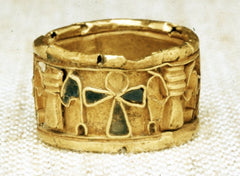
Gold wedding ring with lapis lazuli, with the symbol of life (Anj), the symbol of stability (djed – several pillars) and the symbol of power (was - scepters). Meroitic period 300 AD. - Ancient Egypt & Sudan. Image: British Museum
In his book "The Natural History", Book XXXIII The Natural History of Metals - Chapter 4 The Origin of Gold Rings", Pliny the Elder mentions the custom of giving the betrothed woman an iron ring. ("Pronubus anulo" or engagement ring), as well as the public use of gold rings.
“Those, too, who had received golden rings on the occasion of an embassy, only wore them when in public, resuming the ring of iron when in their houses. It is in pursuance of this custom that even at the present day, an iron ring (annulus pronubus or engaged ring) is sent by way of present to a woman when betrothed, and that, too, without any stone in it.”
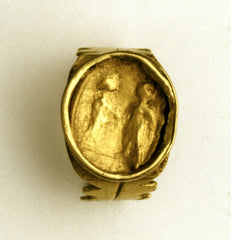
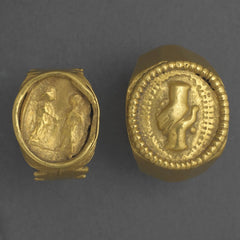
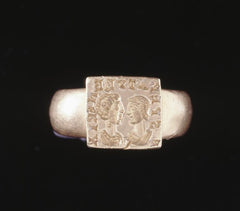
Roman wedding ring from 3rd c. with portraits of a man and a woman as well as a romantic inscription in Latin. From this we can deduce that the Romans began to personalize the wedding rings.
For the ancient Romans, marriage contracts were a very serious matter. If the wedding ring was very expensive, the bride did not wear it every day, but instead used an iron ring. Many of these rings were in the form of a key, another symbol which was likely to signify the woman's control over the valuables of the house.
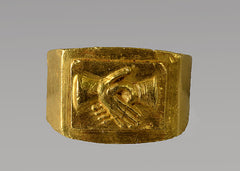
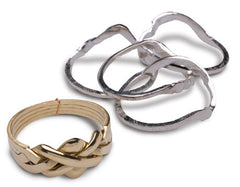
The Liber Iudiciorumor Lex Visigothorum was a set of Visigothic laws, arranged by King Recesvinto and promulgated in 654 AD. This set of laws contained in large part the old Roman laws and included new ones, and were applicable to both the Gothic and Roman populations.
In his book 3, there is express reference to marriage and divorce, and there is also specific mention as to the use of rings in a formal contract of marriage : "When the ceremony of betrothal has been performed, and the ring shall have been given or accepted as a pledge, although nothing may have been committed to writing, the promise shall, under no circumstances, be broken."
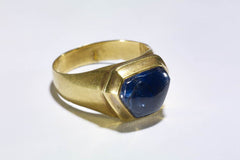
Gold and blue sapphire engagement ring. 13th 15th c. – Source: British Museum
In 860 AD, Pope Nicolas I explained in a letter the practice of the use of engagement rings in the Western Church. This epistle was the reply to a series of consultations formulated by Boris I of Bulgaria regarding the differences between the practices of the Roman Catholic and Eastern Orthodox churches.
One of the earliest documented uses of a diamond engagement ring dates back to 1477, for the engagement of Archduke Maximilian of Austria to Mary of Burgundy.
In 1475, Constanzo Sforza gave Camilla de Aragon a ring of diamonds as a wedding ring as well as this poem:
Two torches in one ring of burning fire
Two wills, two hearts, two passions
All bonded in marriage by a diamond
During the Protestant Reformation, the engagement ring was replaced by a wedding ring.
The Gimmel and Posie rings were very popular in the 18th century. Although Posie rings were also used as a gift to express a feeling that did not involve a formal commitment.
The Victorian era was marked by two very important events. One was the discovery of diamonds in South Africa in 1866, which resulted in an increase in production of diamond mines, making them more popular, although they were still used by the aristocrats and nobles of the time.
Another event, also very important to the jewellery world, was the romantic feeling of the Victorians. During this period, a new trend was set. Ring designs became more striking, and a great number of different gemstones, such as emeralds, garnets, rubies, spinels, amethysts, topazes, aquamarines, peridot, etc. began to be used more often.
Following World War I and the Great Depression, the purchase of engagement rings dropped dramatically in the United States, and the price of diamonds plummeted. The company De Beers carried out one of the best marketing campaigns to date with their globally famous slogan "a diamond is forever".
We owe thanks to Tiffany & Co for the design of the six-point engagement ring that raised the diamond above the band, with its celebrated Tiffany Setting.
Another very famous design in terms of engagement rings is Cartier's Trinity ring (1924), which consists of 3 interlaced bands, made of 3 different coloured gold; yellow gold (symbolizing fidelity), white gold (friendship) and rose gold (love).
Today, and partly as a result of globalization, we are more open to other cultures, trends, news, etc. This has lead to the adoption of those practices that best fit our way of being.
One of the rules is that there are no established rules or customs. Many countries now allow same sex marriages, and the role of asking for someone’s hand in marriage is not exclusively a man’s role, so both engagement and wedding rings can be both offered and used by men as much as by women, and they can freely decide whether or not they want to use them as symbols of their commitment.
So, nowadays we prefer to customize these small bands so that they are unique and unrepeatable, just like us.
There was a belief that a vein that went directly to the heart ran from the fourth finger of the left hand, and this vein was called "vena amoris." The circulatory system was unknown at the time, but this is most the reason that engagement and wedding rings are placed on the "ring finger" or the fourth finger.
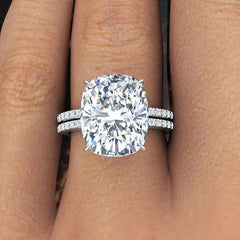
Throughout history, and depending on the geographical area, rings have been worn on different fingers of the hand. In England, during the seventeenth century, wedding rings were usually worn on the thumb; the Gauls and the Britons wore them on the middle finger or the tall finger. In some countries it is standard practice to wear the engagement ring on the right hand and then swap it to the left following the wedding ceremony, but customs vary throughout the world. On what finger and on what hand we place the rings depends on, among many other factors, different cultures.
We cannot talk about engagement and wedding rings without talking about marriage. Marriage as we know it today has varied throughout history. We know the customs for weddings in antiquity thanks to the official descriptions of weddings written about between rich and influential people. The actual act of marriage was a parade which highlighted how powerful these families were, with great banquets, games, shows, etc.
From 15th century on, the wedding ceremony was more public with the community participating more. During this rite, the father gave his daughter away with the husband then taking her to his house. Like many other gifts, the bride became the property of the husband, as just another object. Needless to say, these weddings were sometimes agreements between states, and although they had nothing to do with love, this was no reason for them to convey any less symbology.
It was not until 1563 that the sacrament of marriage became regulated, in the Council of Trent, during the reign of Pope Pius IV. Until then, mutual consent was enough, it was not necessary to marry in the church, or for a priest to preside over the sacrament, and of course, rings, witnesses, and so on were not necessary. Clandestine marriages were common, as it was the only way to secure "a wedding for love".
There were several very symbolic rites within the marriage ceremony, such as the “impalement” (impalmamento), that is, the moment when hands were intertwined in the signing of the nuptial contract. Or the "ringing" or “day of the ring” (anellamento), when the ring was placed on the finger and the vowes were exchanged. This was usually performed in the house of the bride, with the father or guardian as witness. The bride was then publically taken to the husband's house, a custom that was called "menare a casa". Fede rings were widely used during the Renaissance and they represented the marriage ceremony in a concise manner.
Gemstones are closely related to religious and human beliefs, and for centuries gems have been attributed magical powers. In ancient writings, such as those by Pliny the Elder, not only had the physical properties of gemstones already been described, but their magical powers and other virtues had also. Birthstones, or fortune stones, have been used in antiquity and are still used today.
Just as today we endow diamonds with the "power" of eternal love, centuries ago those same powers were attributed to many other stones; rubies were "beneficial to health," aquamarines offered "protection," pearls symbolised " purity", etc.

Today, the market offers a very wide selection of places to choose the best gemstone for our own wedding or engagement rings. There are gems with very good hardness and a great range of colours, such as tourmalines, spinels and sapphires. We can also find synthetic stones at a good price, and natural stones at any price range we can imagine. All the choices are good, from diamonds to zirconias.
All you have to do is think about the design of your ring, whether it is going to include a gemstone, which gemstone we like the most, choose the one most appropriate in regard to colour, size, budget, etc. And once we have everything, we need only to put a lot of love into it.
Do not forget to visit our blog about Engagement Rings with History, and discover from Byzantine rings to the diamond rings of today.
Acknowledgments
Special thanks to Jenny Marchese (www.wildflowerfloralevents.com) for trusting us and letting us participate in this beautiful project. You have created a very special ring with one of my gems, adding diamonds loaded with family history and love.
To Roser and Bene for letting me be part of your life.
To my customers for trusting us and customize their jewelry with my gems.
Really really thanks to all.